 & Telegram
& Telegram  Channel
Channel  & Telegram
& Telegram  Channel
Channel 
Ruben Ostlund’s masterful Force Majeure depicts the moral crises of human beings when confronted by a natural calamity. Awarded the Jury Prize in the Un Certain Regard section at the 2014 Cannes Film Festival the film raises a few questions on the role of human beings as a social animal different from others. A Silhouette review.
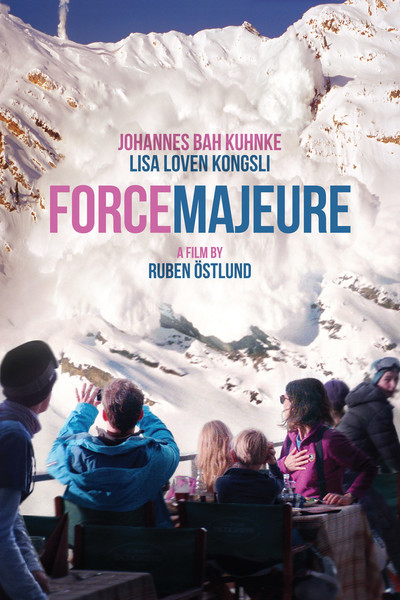
Ruben Ostlund’s Force Majeure
‘Man is by nature a social animal’ – said Aristotle.
The obvious question that comes with it is: What is the true nature of this social animal called ‘man’? Among the various natures and more so among the varied roles played by a man in the drama of his entire life which one is his real ‘he’? Or shall we suppose that all such roles are in fact forms of social prejudice and in reality a person is either a male or a female because gender is the only characteristic which is clearly preordained. Even then, the word ‘social’ that precedes the word ‘animal’ suggests that however perfect the above male-female division might appear to be what is suitable for ‘animals’ is not at all a simple matter in the ‘ society’ of ‘social animals’.
Let us consider the institution of marriage. However vulnerable marriage is getting day by day its social utility and moreover its complexity of engagement can never be denied. It is in this context that we recall the film Force Majeure the one which we are going to talk about.
Force Majeure is the fourth film directed by the Swedish film maker Ruben Ostlund in 2014. Ostlund said in an interview that the film had been inspired by a factual event. A married couple who is his friend was on holiday in Latin America. During a dinner a gun-man suddenly entered the restaurant and started shooting at random. At that time the husband without caring to save his wife tried to hide himself for survival. The incident shocked the wife so greatly that as Ostlund described, ‘she could not stop after a glass of wine or two, telling the story over and over again’. [1]
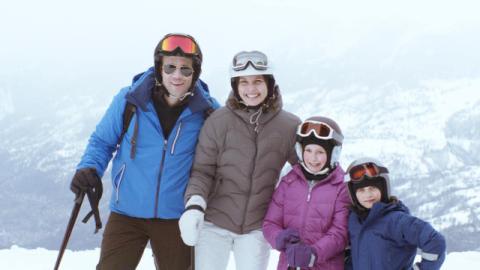
‘Force Majeure’ opens up with a happy family which soon gets dishevelled due to an accident
In Ostlund’s film the incident takes place in a luxurious elite hotel in French Alps. The couple is accompanied by their son and daughter. The gun-fire is replaced by the natural calamity ‘avalanche’. At the beginning of the film, where the entire frame is rendered white with snow, the four persons enter one by one hand in hand with a photographer. The picture perfect photographs remind us of the famous introspection in Anna Karenina: “Happy families are all alike; every unhappy family is unhappy in its own way.”
Next we learn from Ebba (Lisa Lovenkongsli) that Tomas (Johannes Kuhnke) has taken leave from work to spend some time with his family amid this lush nature. Here at the outset Ostlund skillfully acquaints ourselves with Charlotte (Karin Myrenberg) who will make her appearance every now and then throughout the film as a contrast or a counter-point, as an inquisitive onlooker and an amusing woman. Charlotte informs us that she has left her two children behind at home and has arrived here only to provide some leisure to herself. In spite of being separate from others every human being, under normal circumstances, is part and parcel of a family and being such, part and parcel of a society. On the other hand, a human being while being an integral part of a family or a society is also a separate and independent individual in terms of liberalism. This is how Tomas, Ebba and Charlotte unfold their positions in the setting of the film. By the way, we would like to inform the readers that Ostlund started his film career with a film on skiing. In the present film also, time and again, the ski-scenes appear in conformity with the emotional interplay of various characters without failing to do full justice to film language.
The film opens with the entire family enjoying skiing in a cheerful holiday mood. The characters have started unveiling themselves and no crisis is in sight. Crisis looms large as they get hungry out of tiredness of skiing when Tomas and Ebba with their two children reach the terrace of an open-air restaurant for food. All of a sudden there is an avalanche which is actually man-made and looks controlled. But immediately afterwards it seems to engulf the restaurant creating panic among the people on the terrace. Tomas flees from the spot for some time to save his life whereas Ebba stays there to protect her children. Needless to say, this event makes Ebba dumb with amazement. Grave questions regarding the love of Tomas fill her heart which is severely torn by internal strife.

As the avalanche approaches, Tomas flees leaving behind his family and children
It has already been mentioned that the story is based on a real event. Nevertheless, the wise director has confined the prime event to the arena of dinner table thus opening up a significant side of our thought. It is in this arena that a social animal differs from other animals. When the stomach is full a social animal is captivated by the eternal mystery of light and darkness of life and the world, mingled together. The problems of an ordinary animal persist only until its stomach is full while those of a human being start only after his basic needs are fulfilled or after the advent of some extraordinary realization.
Think about sex. To an animal, it is just a periodic organic activity. But to a man it is the source of so many ideas and dreams, of numerous and strange forms of jealousy; it has so many overt and covert manifestations in various forms of art. In fact, an animal is almost a ‘programmed software’ whereas a man is a sort of ‘open-ended software’. That is why Ebba’s internal strife appears to be a logical exposition of her emotions.
A thief does not become a sage by distributing blankets on a single day only. Likewise, a sage does not become a thief by stealing once due to some irony of fate. This is what Mats (Christofer Hivju ) tries to convince Ebba. Mats and Fanny (Fanny Metelius) are two characters of the film who come to see Ebba’s family at the hotel. Mats has also left behind his family and come here for a holiday with Fanny, much younger in age.
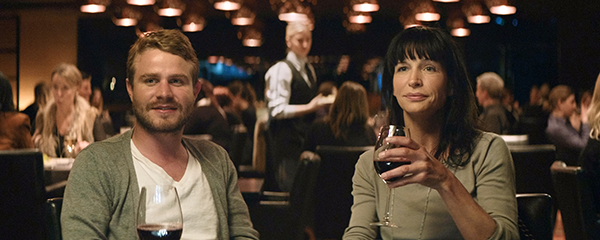
Charlotte and her new boy friend listen to Ebba’s story
Ebba previously opened her grief-stricken heart to Charlotte and her new boy friend at the restaurant. Ebba’s worries together with Tomas’ helpless plight and his somewhat foolish denial of fleeing rouses a comic feeling in us as well as in Charlotte. When Ebba now repeats her words to Mats and shows him the videos in the mobile phone as evidence, Mats brings forth another view-point.
The point raised by Mats is that in a patriarchal society women and also the society at large desire to see a heroic image of men. However, just as the real reason for imposing godliness on primordial forces like the devastating power of fire, the mighty currents of water, air etc is that, we have no control over them, in the same way another concurrent and valid reason is the primitive instinct for ‘self-defence and survival’. Does Mats try to spell out this fact along with his patriarchal notions? Yet to behave abnormally out of panic and to flee for saving one’s own life leaving alone one’s wife and children are not to be judged on the same footing. Ebba perhaps repeatedly wants to say this and also that she has proved it by staying behind with her young children. We discover tears also in Fanny’s eyes as in Ebba’s showing that as women they are in the same mental plane. In fact, Fanny believes that Mats will behave similarly if a similar incident happens to them. After listening to Mats’ words Fanny brackets him with Tomas.
The film reveals how without anybody’s notice the male people are trapped under the pressures of patriarchal society. Moreover, the film makes us reflect on whether we are not becoming too much gender-biased as a result of the clamor for ultra-feminism. Outside the male-female divide the space for conceiving a human being as a human being alone with all its virtues, faults and follies is shrinking day by day. Every man or woman is prone to make mistakes. [It would not be totally out of place to remark here that, a man and a woman are equal as well as different. It is neither possible nor necessary to make a man and a woman identical in all respects. Human society is likely to lose a great deal if in the name of demolishing patriarchy it regards all the feminine qualities women are naturally endowed with as something derogatory. But we shall not dwell on this issue.]
Coming back to the narrative, after some time we find Ebba seriously thinking about the permanency of her relationship with Tomas although it is not clear whether only as a result of the prevailing crisis or not . It will be instructive to note that Ostlund carried out a research after he came to know the incident of his couple-friend. Data were collected on couples who were victims of ship-wreck and Tsunami. To his great surprise Ostlund found that quite a large percentage of couples surviving the catastrophe finally got divorced. [2].
Ebba finds an opportunity to talk to Charlotte and enquire about her several male companions, and also about the chemistry and responsibility of her relationship with her husband and children if she pursues this kind of life. We realize that Charlotte belongs to a society that admits unlimited freedom of choice and so she is adept in taking the risk of maintaining such relationships, whereas Ebba-Tomas represent that bigger social group in which after all misfortunes the society maintains the status quo. That is why Ebba goes alone for skiing to have some exclusive time for herself and bursts into tears affectionately when she suddenly catches sight of Tomas, Vera and others from a long distance.
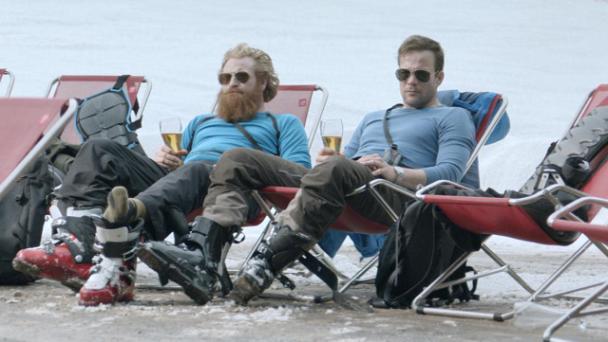
Mats and Tomas relax after a skiing adventure in which Tomas opens up and releases his agony in front of the magnaminity of Nature
Tomas also goes to the Alps with Mats for skiing. Is it for sharing his trauma with a male friend? Tomas, in a bid to release his agony of mind, yells. A pitiable and helpless Tomas caught in a solemn, smoky and vast setting of nature reminds us of David Locke in Antonioni’s film The Passenger. When Locke’s car is stuck in the Saharan desert he finds himself in a dumb, cruel and indifferent nature, himself nothing but a plaything and cries out, “Alright, I don’t care.” The fact that man’s inner mental world is as complex and multilayered as the external world is borne out by these two sequences of two different films which proceed from two different sides to merge together and arrive at the same realization. Tomas, it appears, finds his forgotten inner self and weeps like a kid. Pure love for an offspring, beyond the bounds of space and time, which does not allow a couple to tear off their bond even after a storm or thunderbolt in their relationship plays its role here in this film and finally warms up the chilled atmosphere. Tomas, Ebba and the children weep together.
The film lays bare the graph of ups and downs in the relationship of Tomas and Ebba in their personal life and this is supplemented by their public life represented by the character of a house keeper which Ostlund introduces in his own typical style. By means of a fine filmic treatment the director fixes a small sticker on a door which Tomas rubs out. Whose voyeurism is this? The dichotomy of private and public life is a favourite topic of Ostlund which is presented in a much larger dimension in his latest film The Square.
The tune, rhythm and metre of this mature and multilayered film have been set with such perfection that another skiing expedition of Tomas and Ebba towards the end of the film where Tomas rescues Ebba lost in dense mist creates a sort of melodrama and is possibly unnecessary. The ties between Tomas and Ebba have never been ripped apart in this film and it has never appeared that their relationship is frozen as heavily as the dumb and cold environment of the Alps. The film is not at all linear or one-dimensional in nature and so we may overlook the small dislocation cited above, especially in consideration of its excellent climax.
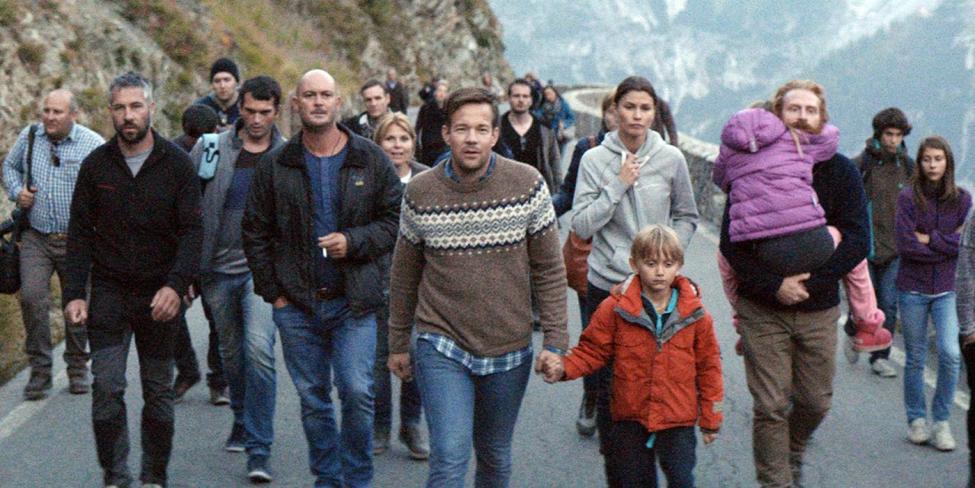
The last scene of Ruben Ostlund’s Force Majeure
While returning after the holidays along the dangerous roads of the Alps the bus carrying Tomas and others frequently gets stuck due to an apparent inefficiency of the driver. As a representative of the majority of passengers [which, incidentally, symbolizes the mentality of broader social groups of common people] Ebba manages to persuade all the passengers to get down from the bus. Mats, who has been equated to Tomas by Fanny from her anti-patriarchal standpoint, reminds all the passengers not to get into a panic and as per civilized norm to allow the children and the ladies to alight first. The far-sighted director with a fine touch makes only Charlotte stay in the bus. This selection assumes the sign of an irresistible symbol of the nature of life lived by Charlotte. The bus goes away with Charlotte and we see all other passengers with Tomas, Ebba, Mats, Fanny walking en masse along the road of the Alps. Tomas smokes a cigarette with a face showing an uncertain blend of gloom and relief.
People inside and outside the bus have possibly chosen their respective paths for survival. The path of the insider is as dreadful as the edge of a sharp razor and is not generally adopted by most people. So, finally, the director stays outside the bus in the company of men of the middle path. In fact, a stratified social structure and the idea of dependence on society which we see in this film raises the final question: Has the collective psyche of the West started thinking that reducing step by step excessive dependence on state machinery people need to lay emphasis on society and social bonds? This is the psyche of our own land where the base is society, not the nation-state.
“It is no measure of health to be well adjusted to a profoundly sick society.” – Jiddu Krishnamurti
References:
[1] Force Majeure Review in RogerEbert.com
[2] ibid.
More to read
Silhouette Recommends – On Body and Soul
Suffering of Ninko: Clash of Restraint and Libido
In Argument with Beauty – Once upon a Time in Anatolia
Love as Obsession: Reading Alfred Hitchcock’s The Paradine Case
Whether you are new or veteran, you are important. Please contribute with your articles on cinema, we are looking forward for an association. Send your writings to amitava@silhouette-magazine.com
We are editorially independent, not funded, supported or influenced by investors or agencies. We try to keep our content easily readable in an undisturbed interface, not swamped by advertisements and pop-ups. Our mission is to provide a platform you can call your own creative outlet and everyone from renowned authors and critics to budding bloggers, artists, teen writers and kids love to build their own space here and share with the world.
When readers like you contribute, big or small, it goes directly into funding our initiative. Your support helps us to keep striving towards making our content better. And yes, we need to build on this year after year. Support LnC-Silhouette with a little amount – and it only takes a minute. Thank you
Silhouette Magazine publishes articles, reviews, critiques and interviews and other cinema-related works, artworks, photographs and other publishable material contributed by writers and critics as a friendly gesture. The opinions shared by the writers and critics are their personal opinion and does not reflect the opinion of Silhouette Magazine. Images on Silhouette Magazine are posted for the sole purpose of academic interest and to illuminate the text. The images and screen shots are the copyright of their original owners. Silhouette Magazine strives to provide attribution wherever possible. Images used in the posts have been procured from the contributors themselves, public forums, social networking sites, publicity releases, YouTube, Pixabay and Creative Commons. Please inform us if any of the images used here are copyrighted, we will pull those images down.